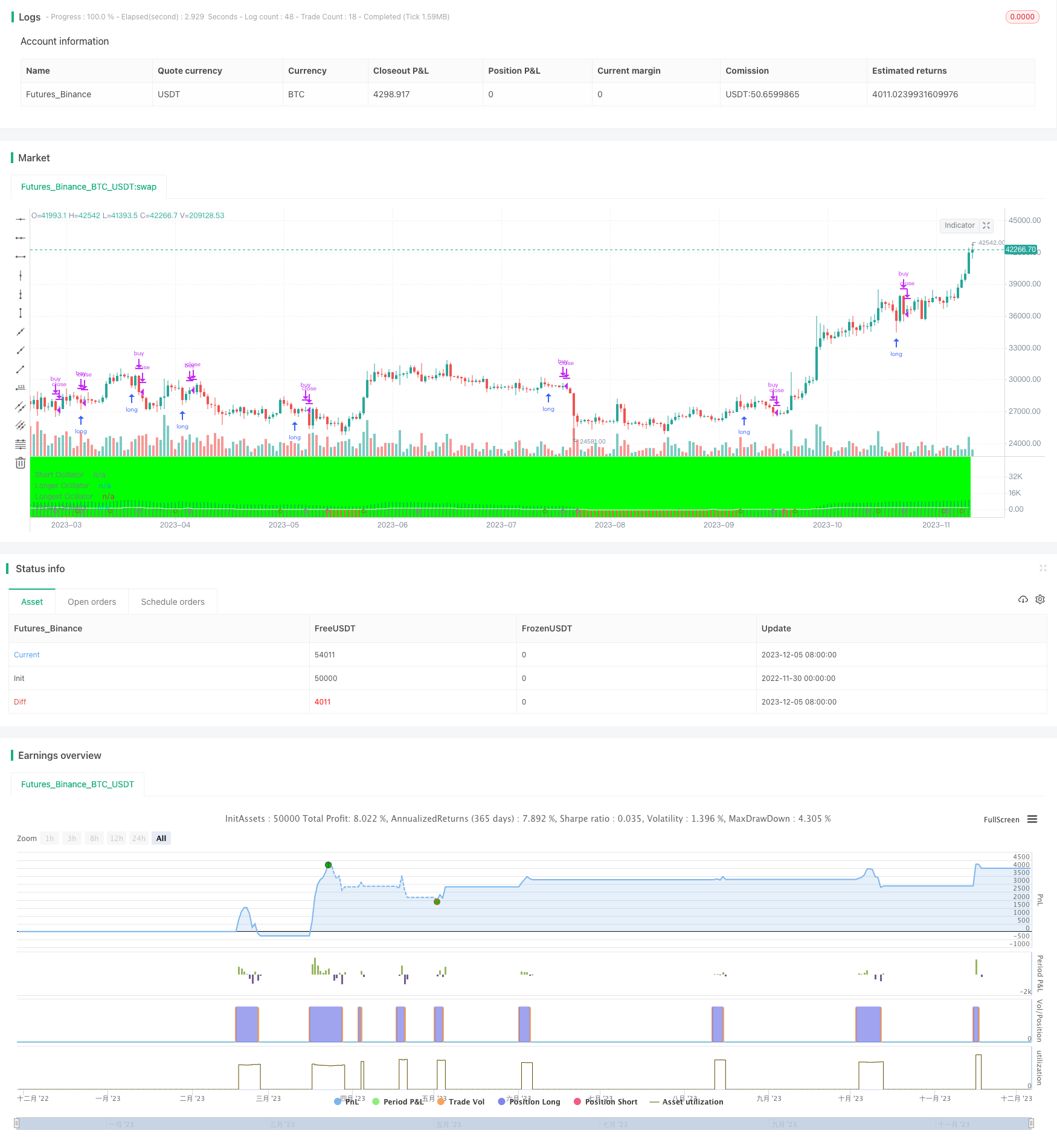
概述
渦涡震荡器趋势追踪策略是一种基于渦涡指标的趋势追踪策略。它利用多个不同周期的移动平均线构建渦涡指标,识别价格的潜在趋势,并结合更短周期的移动平均线作为辅助判断,实现低风险的趋势追踪操作。
策略原理
该策略的核心指标是渦涡指标。渦涡指标由多个不同周期的短期、中期和长期移动平均线构成。具体来说,策略使用了6日、27日、72日和234日四个周期的移动平均线。短期移动平均线反映了价格的最新趋势,长期移动平均线反映了价格的长期趋势。指标的核心逻辑是,当短期移动平均线上穿长期移动平均线时,表明价格上涨势头增强,该买入;当短期移动平均线下穿长期移动平均线时,表明价格上涨势头减弱,应卖出。
渦涡指标显著优点是趋势判断准确,能够有效过滤市场噪音。但其反应不够灵敏,无法及时捕捉转折点。因此,策略加入了更为敏感的6日移动平均线,构建辅助判断指标。当渦涡指标和辅助指标同向上穿零轴时买入,同向下穿零轴时卖出。这就形成渦涡指标判断趋势方向和强度,辅助指标判断买卖点的多重确认逻辑,过滤假信号的同时提高操作的灵敏度。
优势分析
该策略最大的优势在于判断准确、操作灵敏。渦涡指标和辅助指标的结合,实现了趋势判断和具体买卖点确定的有机统一,又各司其职避免相互干扰。多重确认机制可有效过滤市场噪音,避免错误操作。同时辅助指标的加入也保证了策略的操作灵敏度。
相比单一指标策略,该策略综合运用多个指标的优势,对市场变化的识别和应对能力更强。在大趋势不变的情况下,策略可实现稳定盈利;当大趋势发生转变时,策略也能够快速响应,降低损失。
风险分析
该策略主要风险在于指标参数设置不当和突发事件的影响。移动平均线参数设置需要权衡灵敏度和抗噪声干扰能力,如果参数设定不当,会导致策略行为反常。此外,重大突发事件也可能导致价格出现剧烈波动,使指标失效,从而产生错误交易。
为降低这些风险,建议优化参数组合并进行回测,使指标表现更为稳定。另外也需要关注重大事件带来的市场影响,必要时暂停策略,避免异常波动期的错误操作。当价格趋势性下降时,逐步减少仓位也是一个有效的保本手段。
优化方向
该策略可从以下几个方面进行优化:
优化移动平均线参数,提高指标的抗干扰能力和操作灵敏度。可以尝试不同长度参数的组合,选择平稳且敏感的指标。
增加止损机制。当价格向不利方向突破关键支持位时,设置止损点,避免进一步损失。
结合其他指标判断,增加策略稳定性。例如加入成交量指标,只有在成交量放大的情况下才产生交易信号。
根据不同市场阶段使用不同参数组合。譬如牛市时采用更为积极的参数,熊市时则使用更稳定的设置。
总结
渦涡震荡器趋势追踪策略通过运用渦涡指标判断价格趋势方向和强度,并辅以更敏感的短期移动平均线确定具体买卖时机。该策略成功结合了趋势判断和交易执行两个层面,既保证了操作的稳定性,也提高了策略的灵活性。通过参数优化、止损设置以及状态机制的引入,有望进一步增强策略抗风险能力,获得更优秀的回测指标和实盘表现。
/*backtest
start: 2022-11-30 00:00:00
end: 2023-12-06 00:00:00
period: 1d
basePeriod: 1h
exchanges: [{"eid":"Futures_Binance","currency":"BTC_USDT"}]
*/
//@version=3
//swap strategy line for study line to enable backtesting
strategy(title="Vortex Ocillator" )
//study(title = "Vortex Oscillator", precision = 6)
// Component Code Start
// Example usage:
// if testPeriod()
// strategy.entry("LE", strategy.long)
testStartYear = input(2017, "Backtest Start Year")
testStartMonth = input(01, "Backtest Start Month")
testStartDay = input(2, "Backtest Start Day")
testPeriodStart = timestamp(testStartYear,testStartMonth,testStartDay,0,0)
testStopYear = input(2048, "Backtest Stop Year")
testStopMonth = input(7, "Backtest Stop Month")
testStopDay = input(30, "Backtest Stop Day")
testPeriodStop = timestamp(testStopYear,testStopMonth,testStopDay,0,0)
// A switch to control background coloring of the test period
testPeriodBackground = input(title="Color Background?", type=bool, defval=true)
testPeriodBackgroundColor = testPeriodBackground and (time >= testPeriodStart) and (time <= testPeriodStop) ? #00FF00 : na
bgcolor(testPeriodBackgroundColor, transp=97)
testPeriod() => true
// Component Code Stop
//vortex histogram
short_input = input(6, minval = 1)
long_input = input(27, minval = 1)
longer_input = input(72, minval = 1)
longest_input = input(234, minval = 1)
short = sma(close, short_input)
long = sma(close, long_input)
longer = sma(close, longer_input)
longest = sma(close, longest_input)
hist = short - long
longhist = short - longer
longesthist = short - longest
hist_fractal = input(3, minval = 0)
longhist_fractal = input(2, minval = 0)
longesthist_fractal = input(4, minval = 0)
vortexhist = avg((hist / hist_fractal), (longhist / longhist_fractal), (longesthist / longesthist_fractal))
crossover_calc = vortexhist > 0 and vortexhist[1] < 0
crossunder_calc = vortexhist < 0 and vortexhist[1] > 0
crossover2 = crossover(vortexhist, 0)
crossunder2 = crossunder(vortexhist, 0)
hist_color = hist > 0? fuchsia : purple
longhist_color = longhist > 0? olive : orange
longesthist_color = longesthist > 0? teal : blue
vortexhist_color = vortexhist >= 0? green : red
plot(longesthist, "Longest Ocillator", style = histogram, color = longesthist_color, transp = 5)
plot(longhist, "Longer Ocillator", style = histogram, color = longhist_color, transp = 30)
plot(hist, "Short Ocillator", style = histogram, color = hist_color, transp = 30)
plot(vortexhist, "Vortex Ocillator", style = columns, color = vortexhist_color, transp = 40)
plotshape(crossover_calc,title = "Crossover",location = location.bottom, style = shape.triangleup, size = size.small, color = green)
plotshape(crossunder_calc,title = "Crossunder",location = location.bottom, style = shape.triangledown, size = size.small, color = red)
//micro
micro_ema_length = input(6,"Micro EMA Length")
micro = ema(vortexhist, micro_ema_length)
plot(micro, title = "micro", linewidth = 1, color = white)
microup = crossover(vortexhist, micro)
microdown = crossunder(vortexhist, micro)
//new micro signals
xmicroup = microup and vortexhist >=0 or crossover_calc
xmicrodown = microdown and vortexhist >=0 or crossunder_calc
plotshape(xmicroup, title = "Micro up", style = shape.circle, color = olive, location = location.bottom, size = size.tiny)
plotshape(xmicrodown, title = "Micro down", style = shape.circle, color = fuchsia, location = location.bottom, size = size.tiny)
//optional strategy options for backtesting, comment out the alertcondition rows and swap the top study row for the strategy row to compile as strategy
if testPeriod()
strategy.entry("buy", true, 1, when = xmicroup, limit = low)
if testPeriod()
strategy.close("buy", when = xmicrodown)
//if (xmicroup)
//strategy.entry("My Long Entry Id", strategy.long)
//if (xmicroup)
//strategy.exit("My Short Exit Id", "My Short Entry Id")
//if (xmicrodown)
//strategy.exit("My Long Exit Id", "My Long Entry Id")